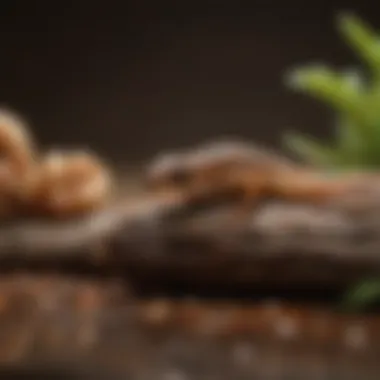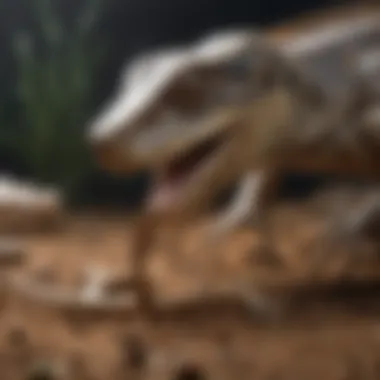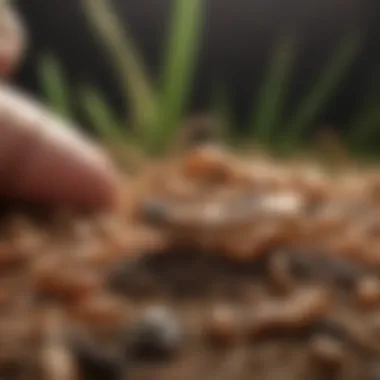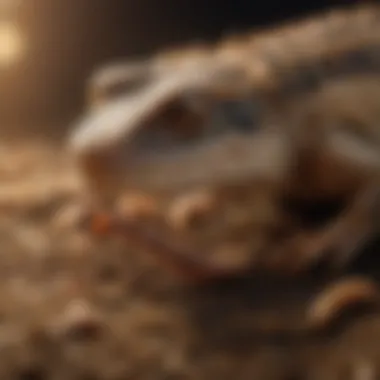The Impact of Mealworms on Reptilian Nutrition


Intro
Understanding the role of mealworms in reptilian diets requires a multifaceted approach. Mealworms, as a prevalent source of nutrition, offer unique advantages for a variety of reptile species. This section delves into critical areas such as nutritional benefits, digestion processes, and feeding practices. It also addresses potential health implications of integrating mealworms into reptiles' diets and explores the ecological impact of mealworm farming. This comprehensive overview is designed to deepen the knowledge of veterinarians, wildlife biologists, and families interested in reptilian care.
Fascinating Facts About the Animal
Unique Characteristics
Mealworms are not worms in the traditional sense but the larval stage of the darkling beetle, Tenebrio molitor. Their unique anatomy includes a hard outer exoskeleton and a soft internal body, allowing them to thrive in various environments. Notably, these larvae are rich in protein, fat, and essential vitamins, making them an excellent food source for reptiles needing high-energy diets. Their small size and adaptability further make them suitable feeders for a variety of reptiles, from lizards to snakes.
Extraordinary Abilities
One fascinating aspect of mealworms is their ability to survive in harsh conditions. They can endure prolonged periods without food or water, a trait that not only enhances their viability as a feeder insect but also raises questions about their ecological impact. Furthermore, they are easy to cultivate. Their rapid life cycle ensures a steady supply, which is particularly beneficial for reptile enthusiasts and professionals alike.
Behavior and Habitat
Natural Habitats
In nature, mealworms are typically found in decaying organic matter, such as rotting wood or decomposing plants. This organic detritus provides them with both sustenance and shelter. Consequently, they play a crucial role in ecosystems as decomposers, breaking down materials and returning nutrients to the soil. When introduced into controlled environments, like terrariums or breeding facilities, it is crucial to replicate these conditions to maintain their health and nutritional value.
Social Structures
Mealworms do not possess social structures like some other insects. They are solitary in nature, often competing for resources. This behavior can influence how reptiles interact with mealworms, as some may prefer live feeding while others benefit from nutrient-rich pre-killed mealworms.
Recent Scientific Discoveries
Latest Research Findings
Recent studies have highlighted the nutritional profile of mealworms, showcasing their high protein content and favorable fatty acid composition. Research indicates that mealworms can be a sustainable food source, particularly in comparison to traditional livestock. Their ability to convert feed to body mass efficiently is notable, enhancing their appeal for reptilian diets.
Breakthroughs in Animal Biology
Innovative studies are exploring the biodegradation abilities of mealworms, particularly their capacity to consume and break down polystyrene. Such findings not only point to their ecological benefits but also suggest a broader potential impact on sustainability in animal nutrition and waste management.
Cultural Significance
Animals in Folklore
While mealworms may not hold significant cultural prominence, they represent efficiency and resilience in various ecosystems. Exploring their role in the food web contributes to understanding larger ecological narratives.
Influence on Art and Literature
In the realm of literature, insects like mealworms often represent survival and adaptability. They may not be the central theme, but they symbolize the interconnectedness of life forms, reminding us of the intricate relationships within ecosystems.
Mealworms are not just food; they are a cornerstone of ecological cycling, contributing to nutrient recycling in their habitats.
By examining these aspects, we can appreciate the role mealworms play beyond being a mere feeder insect, engaging with both ecological importance and the reptilian diets that depend on them.
Preamble to Reptile Nutrition
Understanding reptile nutrition is crucial for the health and well-being of these diverse species. Proper nutrition not only ensures their physical health but also plays a significant role in their growth, coloration, and reproductive success. Every reptilian species has unique dietary needs, which depend on their natural habitats and biological characteristics.
In this article, we explore the importance of mealworms as a valuable dietary component for reptiles. Mealworms serve as a source of protein and other essential nutrients vital for maintaining optimal health. By examining the nutritional profiles of mealworms, we can identify how they fit into a well-balanced diet for reptiles.
Additionally, the considerations around mealworm sourcing and feeding practices are essential. Knowing where to obtain mealworms and ensuring they meet quality standards is key for reptile owners. Also, potential health risks related to improper feeding or contaminated insects must be addressed.
Understanding Reptilian Diets
Reptilian diets are primarily carnivorous, herbivorous, or omnivorous, depending on the species. This dietary classification influences various aspects of their care and management. For example, snake species require high protein content, while tortoises tend to thrive on high-fiber plant materials.


Factors influencing a reptile's dietary needs include:
- Natural habitat and food availability
- Age and growth stage
- Activity levels and metabolism
Reptiles' digestive systems are adapted to their specific diets. Understanding these dietary requirements is vital for any reptile owner or caregiver. Knowing how to replicate these dietary habits can enhance their quality of life significantly.
The Importance of Feeder Insects
Feeder insects, such as mealworms, crickets, and roaches, are an essential part of many reptiles’ diets. Insects provide needed protein, fats, and a range of vitamins and minerals. This makes them not only a convenient option but a nutritionally beneficial one.
When selecting feeder insects, it is important to consider the following aspects:
- Nutritional Content: Feeder insects should complement the primary diet found in the wild.
- Variety: Offering multiple types of feeder insects can prevent nutritional deficiencies and improve feeding behavior.
- Gut-loading: This is the process of feeding insects before offering them to reptiles. It enhances the nutritional content of the feeder insect, effectively benefiting the reptile's diet.
In sum, understanding reptilian diets and the role of feeder insects can lead to healthier animals and more successful breeding practices.
Mealworms: An Overview
Mealworms play a significant role in the diets of many reptiles. These larvae of the darkling beetle, Tenebrio molitor, are not only a source of nutrition but also an important component in the ecosystem of reptiles. Understanding mealworms involves examining their nutritional benefits, life cycle, and practical considerations for reptile keepers.
The relevance of mealworms as a feeder insect cannot be overstated. They serve as a vital protein source, contributing to the health and growth of reptiles. When it comes to the diet of pet reptiles, variety is crucial. Mealworms provide that variety along with important nutrients that may not be derived from other food sources. Additionally, they are relatively easy to source and store, making them a convenience for reptile owners.
What are Mealworms?
Mealworms are the larval stage of the darkling beetle, Tenebrio molitor. They are typically brownish-yellow in color and can grow up to 3 centimeters in length. As a feeder insect, mealworms are popular not only for reptiles but also for other pets, such as birds and fish. Their soft exoskeleton makes them easier for many reptiles to digest. They are also relatively low in moisture content, which is beneficial for reptiles that require specific dietary components.
These larvae can be consumed live or dried, providing flexible feeding options. Mealworms have a moderate fat content and a high protein level, making them a potent energy source. However, they should not constitute the entire diet of a reptile due to their higher fat content compared to other feeder insects like crickets.
Life Cycle of Mealworms
The life cycle of mealworms consists of four distinct stages: egg, larva (mealworm), pupa, and adult beetle. The process begins when the female darkling beetle lays eggs in a suitable environment, such as grain or ground oats. The eggs hatch into mealworms after a period of around two weeks.
Mealworms can grow for several months, depending on environmental conditions and food availability. They undergo several molts during this time, increasing in size with each stage. Once they reach maturity, they enter the pupal stage, where they undergo transformation into adult beetles. This stage lasts about one to three weeks, after which the adult darkling beetle emerges, completing the cycle.
Understanding the life cycle of mealworms is crucial for those interested in breeding them. Knowledge of their development ensures that reptile owners can provide optimal care and nutrition for their animals. Additionally, keeping a supply of mealworms can help manage costs and ensure a constant food source.
Mealworms contribute crucial nutrients to reptilian diets, offering advantages for growth and health while being accessible for enthusiasts.
Nutritional Content of Mealworms
Understanding the nutritional content of mealworms is crucial when considering their role in the diets of reptiles. The composition of these feeder insects, which includes proteins, fats, vitamins, and minerals, directly affects the overall health and development of reptiles that consume them. A well-balanced diet is necessary for proper growth, reproduction, and maintenance of the immune system in these animals. The following sections will delve deeper into the elements that make mealworms a beneficial addition to reptilian diets.
Protein and Fat Composition
Mealworms are rich in protein, typically containing around 20 to 25 percent of their dry weight in protein. This high protein content is essential for reptiles, especially during growth phases, as protein helps with the formation of muscles and the repair of tissues. Moreover, the amino acids found in mealworms contribute significantly to various biological functions, making them a good dietary source for carnivorous and omnivorous reptiles.
In addition to protein, mealworms also exhibit a considerable fat content, usually ranging from 10 to 20 percent. This fat provides a source of energy that is crucial for reptiles, especially those that are more active. However, it is essential to monitor fat intake, as excessive fat can lead to obesity or other health issues in reptiles. Therefore, understanding the balance of protein and fat in mealworms aids keepers in formulating a more appropriate diet for their pets.
Vitamins and Minerals
Mealworms also offer a variety of vitamins and minerals that contribute to the health of reptiles. They are noted for their vitamin content, which includes essential vitamins such as vitamin B12 and vitamin E. Vitamin B12 is vital for neurological function and red blood cell formation, while vitamin E acts as an antioxidant that supports immune function.
Among minerals, calcium and phosphorus levels are of particular importance. A diet high in phosphorus can negatively impact calcium absorption, which is crucial for reptiles, especially those such as tortoises and iguanas that require substantial calcium for shell and bone development. Understanding the mineral content in mealworms allows reptile keepers to balance diets adequately, especially when supplementing with other sources of nutrition.
Mealworms serve as a highly digestible protein source while providing essential vitamins and minerals that enhance reptilian health.
Benefits of Mealworms for Reptiles
The introduction of mealworms into the diets of various reptiles highlights their critical role in promoting overall health and well-being. It is essential to recognize that these insects provide specific benefits beyond mere sustenance. In this section, we will explore the digestibility and nutrient absorption capabilities of mealworms, as well as their contributions to the healthy growth and development of reptiles.
Digestibility and Nutrient Absorption


Mealworms are an excellent choice for many reptiles due to their high digestibility. The unique characteristics of their exoskeleton allow for easier breakdown during digestion compared to other insects. Moreover, the soft bodies of mealworms make them palatable for reptiles of all sizes. This is particularly important for young or smaller reptile species that may struggle with harder food items.
The process of nutrient absorption is vital for reptiles, as they must efficiently extract the essential vitamins, minerals, and macronutrients from their food. Mealworms are rich in protein and fat, which are easily digestible forms of energy for reptiles. This aspect is fundamental as it helps to ensure reptiles receive the necessary calories, especially during periods of rapid growth.
Feeding Strategies for Mealworms
Feeding strategies for mealworms are critical for ensuring that reptiles receive a balanced diet. As mealworms become an increasingly popular food source for various reptilian species, understanding the effective ways to incorporate them into the diet is vital. These strategies not only enhance the health and well-being of reptiles but also address their nutritional needs. Proper feeding techniques lead to better digestibility and allow for optimal growth and development.
Determining the Right Quantity
When it comes to feeding mealworms to reptiles, determining the right quantity is essential. The amount of mealworms a reptile requires can vary based on several factors, including species, age, weight, and activity level. Generally, reptiles should be fed mealworms in moderation to avoid overfeeding, which can lead to obesity and other health issues.
To calculate the right amount, observe the reptile's feeding behavior and adjust accordingly:
- Young reptiles may need smaller quantities, around 5 to 10 mealworms per feeding depending on their size.
- Adult reptiles should have portion sizes that can vary greatly but could typically range from 10 to 50 mealworms or more, depending on their overall dietary needs.
Monitoring the reptile’s weight and overall appearance will help assess whether the current feeding strategy is effective. If the reptile appears healthy and active, the quantity is likely appropriate.
Supplementing with Other Foods
Feeding only mealworms lacks nutritional diversity. Thus, supplementing with other foods is crucial for a well-rounded diet. Mealworms should be part of a varied feeding program that includes different types of insects and other nutrients necessary for reptiles. Here are some considerations:
- Variety in Diet: Offer a mix of feeder insects such as crickets, roaches, and waxworms. This not only provides better nutrition but also encourages natural hunting behaviors.
- Fruits and Vegetables: Depending on the reptile species, incorporating small pieces of fruits and vegetables can provide essential vitamins and minerals. Items like bell peppers or squash can be beneficial for some reptiles.
- Commercial Diets: There are also specialized reptile food products available. These often come with a balanced nutrient profile tailored for specific species and can complement a mealworm diet well.
Sourcing Mealworms
Sourcing mealworms is an essential aspect of reptile care that merits significant attention. The nutritional needs of reptiles can be met effectively with mealworms, but the quality and source of these feeder insects play a crucial role in ensuring both the health of the reptiles and the success of the feeding regimen. Therefore, selecting reliable sources for mealworms is pivotal for reptile owners, veterinarians, and wildlife biologists.
Commercial Sources vs.
Home Farming
When it comes to acquiring mealworms, one can choose between commercial sources or home farming. Each has distinct advantages and disadvantages.
Commercial Sources
Commercial suppliers often offer consistent quality and availability. They maintain large-scale breeding operations that ensure a steady supply of healthy, properly sized mealworms. This can be particularly beneficial for those who need mealworms in bulk or are expressing feeding for multiple reptiles. Also, many suppliers follow stringent health protocols, reducing the risk of contaminants or diseases that could impact the reptiles. However, this option typically incurs higher costs.
Home Farming
In contrast, home farming allows for greater control over the mealworm's diet and living conditions. Breeding mealworms at home can be cost-effective and ensures that reptiles receive fresh and live feed. Successful home farming requires proper knowledge of mealworm habitat, breeding conditions, and maintenance practices. Owners can tailor the diet fed to mealworms, potentially enhancing their nutritional value. However, it demands more time and effort compared to purchasing from commercial sources.
Overall, each option has its place based on the specific needs of the reptile and the preferences of the owner. Evaluating these factors can help determine the best sourcing method.
Quality Control and Safety
Ensuring quality control and safety in mealworm sourcing is vital. Health risks can arise from poor sourcing practices. Contaminated mealworms may harbor pathogens or parasites that can adversely affect reptile health.
To mitigate risks, focus on reputable suppliers with established records. When sourcing mealworms from commercial providers, consider their breeding practices, hygiene standards, and health guarantees. For those opting for home farming, maintaining cleanliness and monitoring for pests are crucial.
Mealworms must be sourced with care to ensure they are healthy and safe for reptilian diets.
The safety of the mealworms goes beyond their physical condition. Their diet matters as well. Mealworms fed on agricultural waste or poor-quality grains may lack essential nutrients, making them less beneficial for reptiles. Therefore, selecting quality mealworms is a critical step in establishing a sound feeding routine.
Potential Health Risks
In the discussion of mealworms in reptiles' diets, the topic of potential health risks is critical. While mealworms can provide significant value as a food source, certain concerns must be evaluated. Understanding these risks is essential for ensuring the safety and well-being of reptiles in captivity.
Choking Hazards in Younger Reptiles


One of the primary health concerns related to feeding mealworms to younger reptiles is the risk of choking. Hatchlings and juvenile reptiles may struggle to consume larger mealworms, which can lead to serious health complications. Small reptiles, particularly those that are still developing their feeding skills, may not have the necessary jaw strength or technique to handle larger prey items effectively.
To mitigate choking hazards, it is advisable to provide appropriately sized mealworms. Here are some recommendations:
- Size Matters: Always choose smaller mealworms for younger reptiles. This reduces the risk of choking significantly.
- Supervise Feeding: Keeping an eye on the feeding process can help ensure that the reptile is ingesting food properly.
- Cutting Mealworms: In some instances, cutting mealworms into smaller pieces might be helpful to decrease choking risk.
By being mindful of these techniques, caregivers can minimize choking hazards during mealworm feedings.
Parasites and Contaminants
Another significant risk associated with mealworms is the potential for parasites and contaminants. Mealworms can carry harmful organisms that may pose health risks to reptiles. If mealworms are not sourced from reliable providers, they can also be exposed to harmful chemicals or bacteria during cultivation.
When sourcing mealworms, consider the following:
- Reputable Suppliers: Purchase mealworms from well-known vendors who adhere to safety standards. This reduces the chances of receiving contaminated food.
- Inspection: Before feeding, inspect mealworms for signs of unusual behavior or appearance, such as discoloration or unusual smells.
- Proper Storage: Store mealworms correctly to prevent bacterial growth or pest infestations that can occur in poorly managed environments.
Proper sourcing and handling of mealworms is crucial to ensure a healthy diet for reptiles. A thorough assessment of potential risks can enhance the reptiles' health and overall quality of life.
Environmental Considerations
Understanding the ecological impact of mealworm farming is vital in today's context of environmental sustainability. This section delves into the principles of mealworm farming, addressing both its sustainable practices and potential repercussions on reptilian ecosystems.
Sustainability of Mealworm Farming
Mealworm farming presents a unique opportunity for sustainable protein production. These insects require significantly less land and water compared to traditional livestock. The production process emits fewer greenhouse gases, thus contributing less to global warming. Additionally, mealworms can thrive on organic waste, such as vegetable scraps. This not only reduces food waste but also promotes a circular economy.
Another benefit of mealworm farming is its efficiency in converting feed into edible protein. According to studies, mealworms can convert about 2 kg of feed into 1 kg of body mass. This remarkable conversion rate means that resources are used more efficiently, making mealworm farming a potential game-changer in the quest for sustainable animal husbandry.
Impact on Reptilian Ecosystems
The role of feeder insects like mealworms can also extend beyond the confines of captivity. When mealworms are sourced responsibly from local farms, their impact on local ecosystems can be minimal. However, introducing non-native insects can lead to unforeseen consequences. For instance, if mealworms escape into the wild, they could disrupt local food chains and compete with native species.
It is crucial to monitor the sourcing practices to mitigate such risks. Farmers must ensure that their insects do not interact with wild populations unless they are verified to be from local strains. This reduces the risk of infestation and maintains the delicate balance in local ecosystems.
Responsible sourcing practices are integral to preserving local biodiversity while satisfying the dietary needs of reptiles kept in captivity.
Implemented with care, mealworm farming can coexist harmoniously with natural habitats. The insights gained from this balance can also assist veterinarians and wildlife biologists in promoting practices that protect both reptilian nutrition and the ecosystems they inhabit.
Culmination
The conclusion serves as a vital section in this article, encapsulating the key learnings regarding mealworms and their relevance in reptilian diets. Understanding the intricate role of such feeder insects not only garners appreciation for their nutritional content but also addresses the significant implications for reptile health and well-being.
In summary, this article elucidates compelling insights into the benefits that mealworms provide to reptiles. These insights include their digestibility, protein and fat composition, and overall contribution to the growth and development of various species. Moreover, the potential risks associated with mealworm consumption, such as choking hazards and contamination, highlight the need for informed practices among reptile caretakers.
Benefits include:
- Nutritional efficiency
- Easy sourcing and preparation
- Promotion of a balanced reptilian diet
In light of the growing interest in sustainable feeding practices, evaluating mealworm sourcing is crucial. The comparison between commercial sources and home farming opens avenues for enthusiasts and professionals to explore diverse feeding strategies without compromising quality. As such, the conclusions drawn here not only reflect a summation of key insights but also underscore ongoing discussions about healthy, ecologically responsible pet care.
Understanding the role of mealworms in reptilian diets bridges gaps in knowledge and enables effective feeding strategies.
Summary of Key Insights
The role of mealworms in reptilian diets is multi-faceted and crucial to the health of various species. Several key insights emerge from our discussions. These include:
- Mealworms are high in protein and healthy fats, crucial for supporting reptilian growth.
- They are highly digestible, maximizing nutrient absorption for reptiles.
- Availability of mealworms through commercial farming and home cultivation provides options for reptile owners.
- Consuming feeder insects establishes a natural dietary behavior essential for their psychological health.
Understanding these insights leads to a more profound appreciation for mealworms. Their integration into reptile diets proves beneficial for both nutritional value and ease of sourcing.
Future Directions in Reptile Feeding Practices
As reptilian enthusiasts continue to explore improved feeding practices, the outlook for mealworm consumption remains promising. Future directions may focus on several aspects:
- Research on Alternative Feeder Insects: Exploring other insects that may offer complementary nutritional benefits.
- Sustainable Farming Practices: Advancements in mealworm farming that are more environmentally friendly and efficient.
- Consumer Education: Enhancing knowledge about the importance of balanced diets and how mealworms fit into that framework.
- Technological Innovations: Utilizing technology to improve the manner in which mealworms are raised, harvested, and sold, ultimately ensuring top quality.
By considering these developmental trajectories, the reptile community can optimize feeding practices, ensuring animal welfare and a sustainable ecological footprint.







